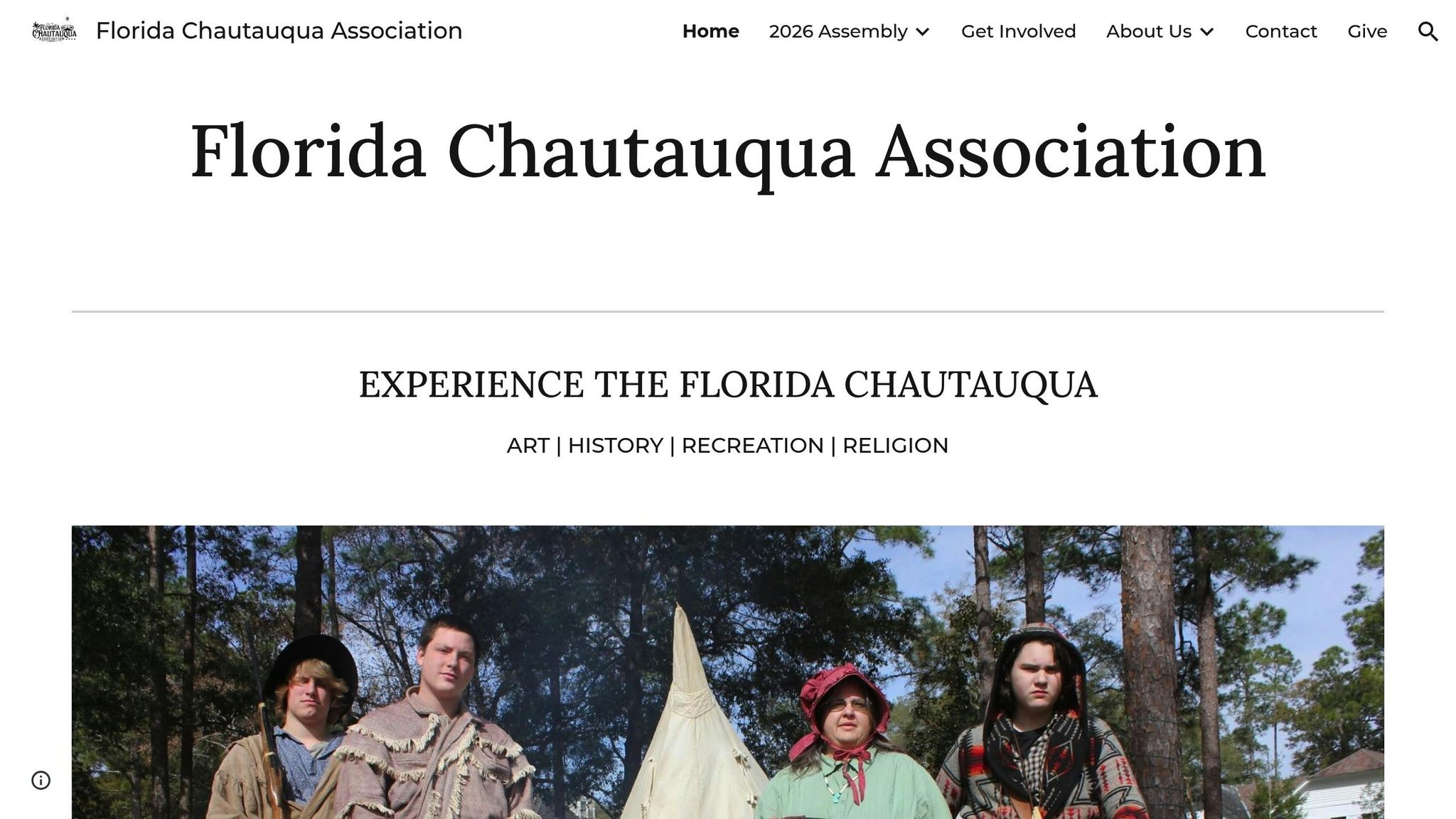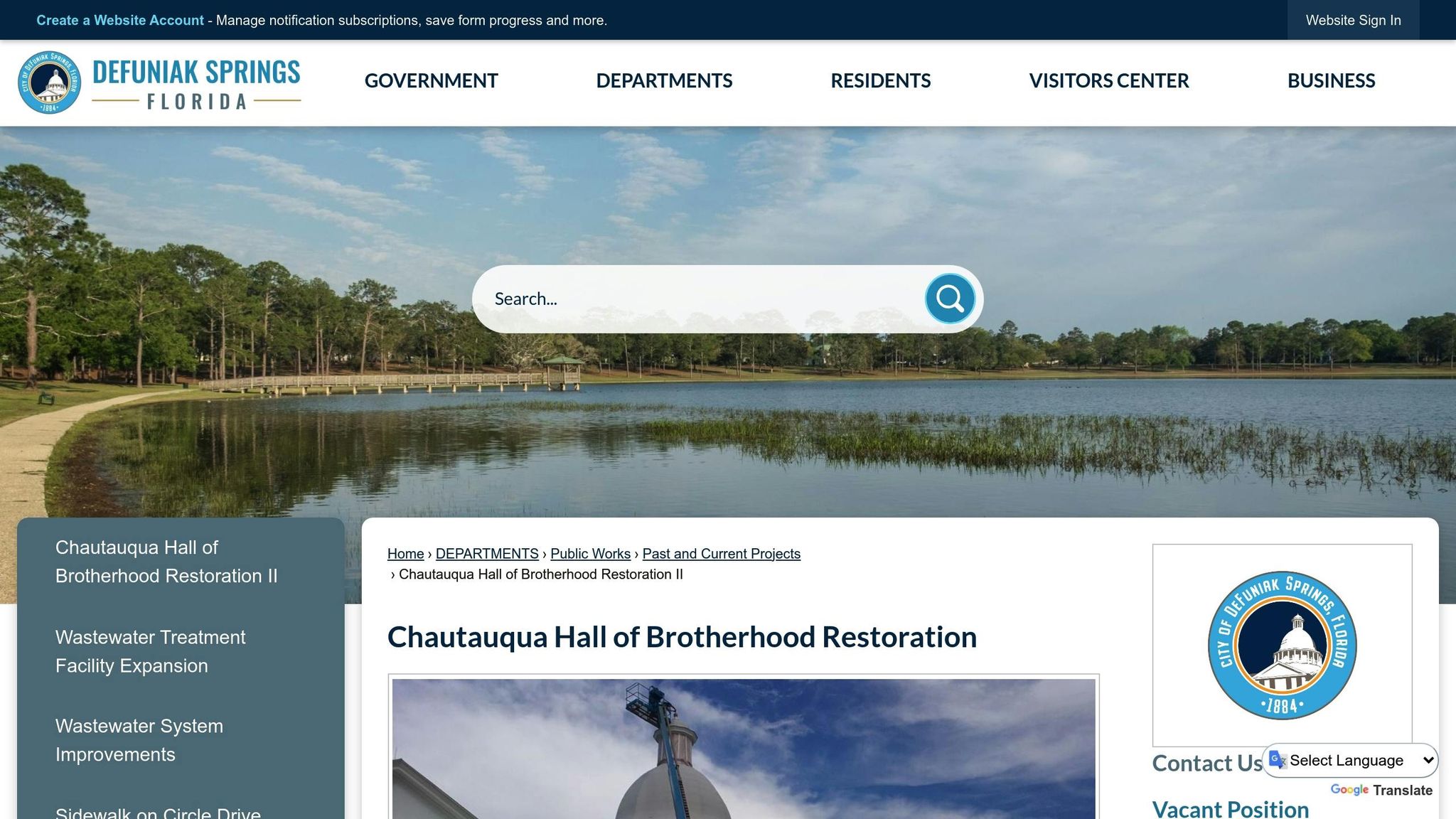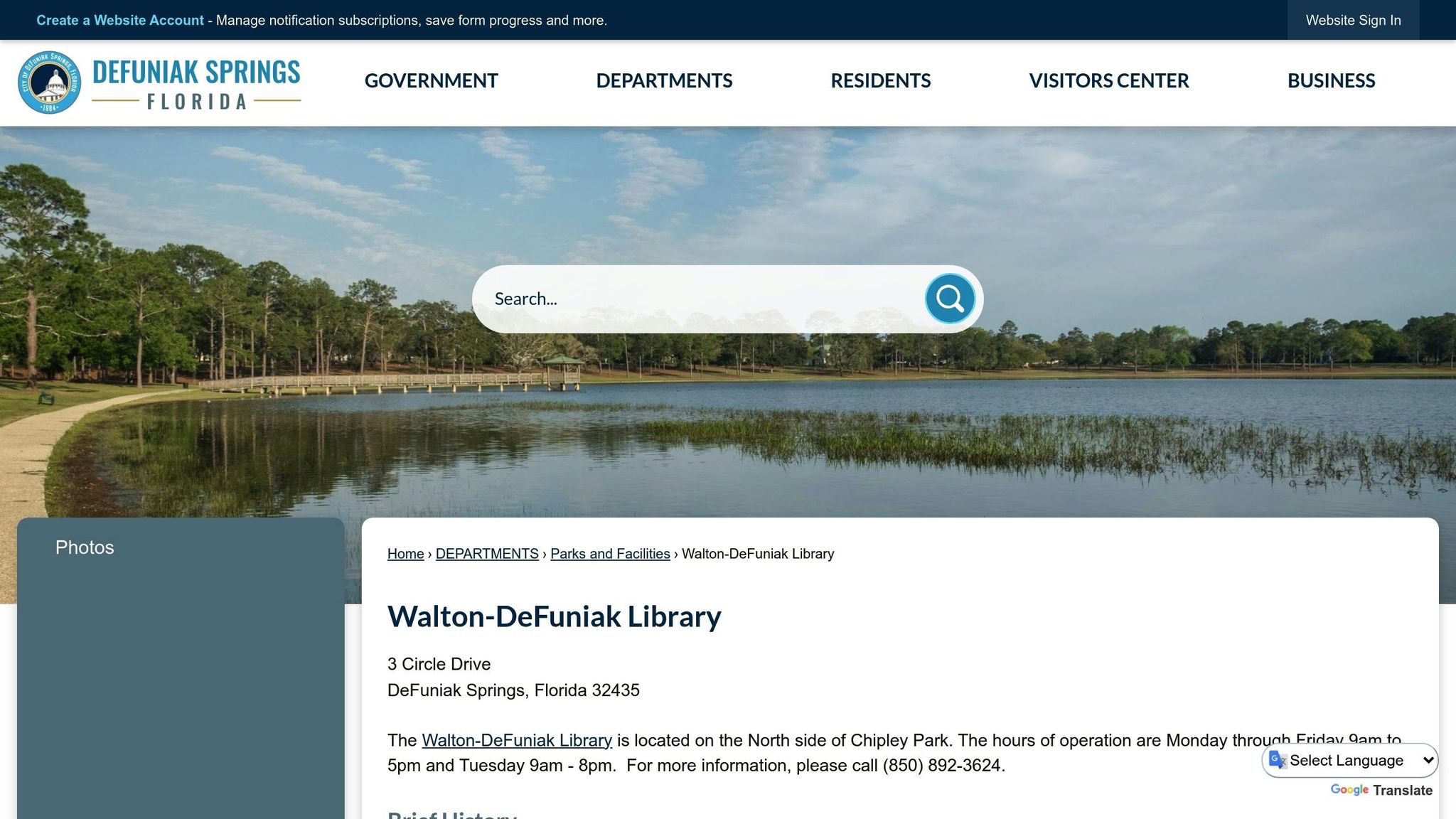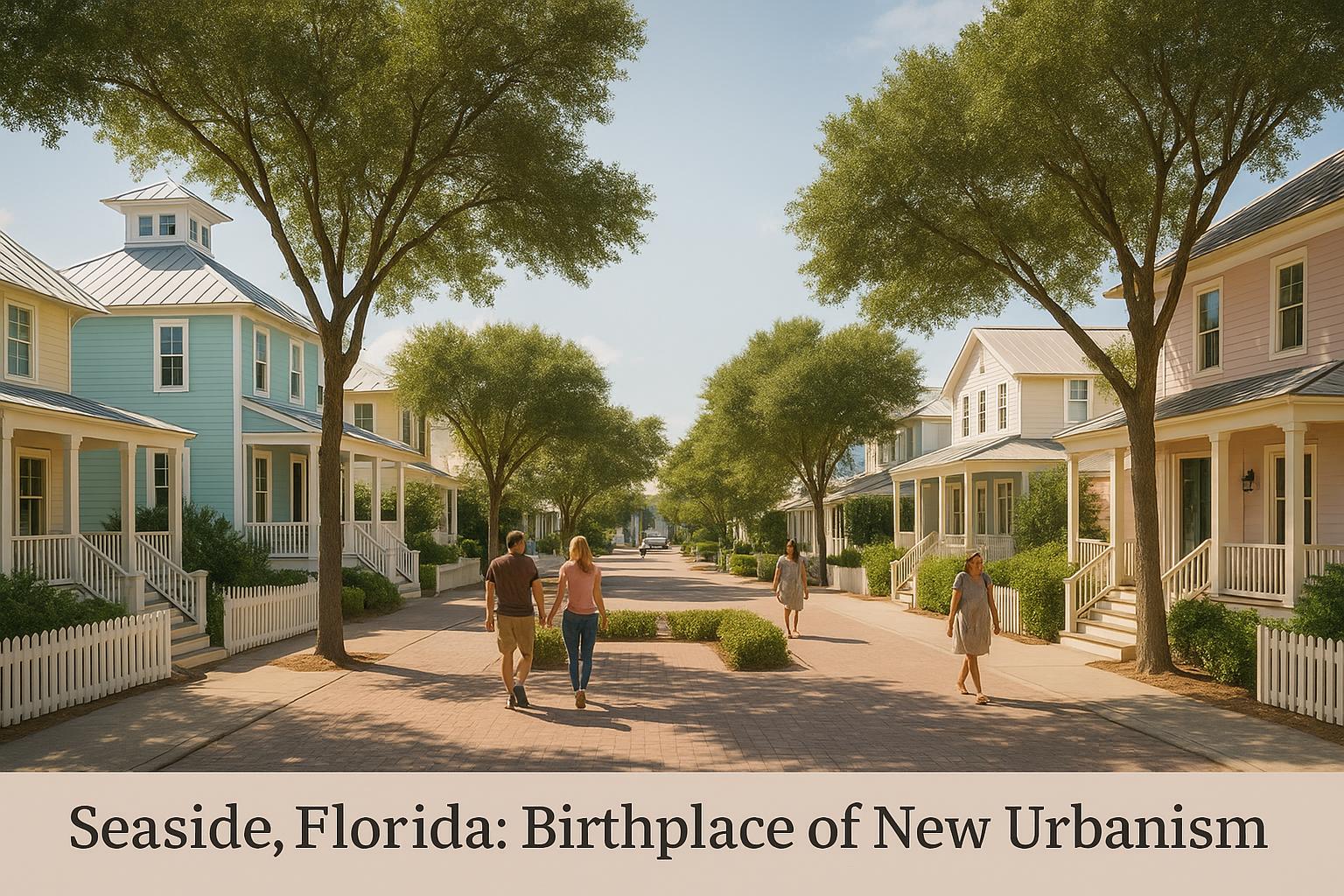Nestled in Walton County, Florida, the DeFuniak Springs Historic District offers a glimpse into 19th-century life with over 130 preserved Victorian-era buildings. Known for its ties to the Chautauqua movement, this area blends historical architecture with a rich legacy of education and community events. Key attractions include Lake DeFuniak, the Chautauqua Hall of Brotherhood, the Walton-DeFuniak Library, and the L&N Train Depot. Visitors can enjoy walking tours, historic landmarks, and seasonal events, with the best times to visit being spring and fall. Preservation efforts ensure the district remains a vibrant part of Florida's history.
History of DeFuniak Springs
How DeFuniak Springs Started
DeFuniak Springs came to life in the 1880s, originally serving as a pivotal stop for the Louisville and Nashville Railroad between Pensacola and the Chattahoochee River. The town was named after a railroad official, but its charm extended far beyond its transportation role. Nestled near the picturesque Lake DeFuniak, the area quickly gained attention from entrepreneurs drawn to its natural beauty. What began as a simple rail stop soon blossomed into a thriving community.
The Florida Chautauqua Assembly

In 1884, DeFuniak Springs became the winter headquarters for the Florida Chautauqua Assembly. This movement, which started in New York as a forward-thinking approach to adult education, brought seasonal lectures, concerts, and theater performances to the town from February through April. The influx of cultural activities spurred the construction of the town's iconic Victorian homes, many of which still define its historic district today. The Chautauqua Assembly attracted a wave of visitors, many of whom were so captivated by the area that they decided to make it their permanent home. This cultural momentum helped lay the groundwork for some of the town’s most enduring institutions and events.
Important Events and People
One of the town’s most notable landmarks, the Chautauqua Hall of Brotherhood, was completed in 1909 and became a hub for community gatherings. Although the Great Depression of the 1930s brought an end to the formal Chautauqua programs, their impact lingered. Many seasonal visitors who had fallen in love with DeFuniak Springs chose to stay, contributing to the town’s growth and character.
Another enduring symbol of the town’s dedication to education is the Walton-DeFuniak Library, established in 1887. Remarkably, it still operates in its original building, a rare treasure that reflects the community’s commitment to preserving its rich history. Thanks to ongoing preservation efforts, DeFuniak Springs continues to celebrate its architectural heritage and cultural legacy, ensuring its story is cherished for generations to come.
DeFuniak Springs Florida Tour: Historic Sites, Strange History & Florida's Highest Point!
Historic Landmarks and Top Attractions
The district brims with landmarks that highlight its rich heritage and Victorian elegance. These carefully preserved sites offer a chance to step back in time and immerse yourself in the history of DeFuniak Springs.
Lake DeFuniak
Lake DeFuniak is a natural wonder, known for its almost perfectly round shape and pristine, spring-fed waters. Surrounded by charming Victorian homes, the lake features a scenic walking path that’s especially picturesque during sunrise and sunset. It’s a serene spot to soak in the beauty of the area while glimpsing its historical backdrop.
Chautauqua Hall of Brotherhood

The Chautauqua Hall of Brotherhood stands as a striking example of neoclassical architecture, complete with grand columns and a symmetrical design that nods to its origins in the Chautauqua movement. Today, the hall is a lively venue for concerts, lectures, and other special events. Visitors can admire its original hardwood floors and vaulted ceilings, with guided tours available during scheduled events to delve deeper into its storied past.
Walton-DeFuniak Library

Step into the Walton-DeFuniak Library, a gem housed in its original Victorian structure. With intricate decorative trim and a charming wraparound porch, this library offers a glimpse into a bygone era. Inside, you’ll find rare collections alongside traditional features like card catalogs and vintage reading tables, providing a nostalgic look at historic library operations during guided visits.
L&N Train Depot and Walton County Heritage Museum
The Louisville and Nashville Railroad Depot, a beautifully restored yellow-brick building, once served as a bustling transportation hub. Today, it’s home to the Walton County Heritage Museum, where exhibits tell the story of the area’s railroad history, the Chautauqua movement’s influence, and the evolution of local life. The depot’s meticulous restoration reflects the community’s commitment to preserving its past.
Florida Chautauqua Theatre

The Florida Chautauqua Theatre continues the district’s tradition of live performances in a lovingly restored space. From plays to musical productions, the theatre’s programming celebrates the artistic spirit of the original Chautauqua events. Guided tours are available during select performance seasons, offering an insider’s view of the theatre’s history and the care taken in its restoration.
sbb-itb-d06eda6
Tips for Visiting the District
If you're planning a trip to the DeFuniak Springs Historic District, a little preparation can turn a simple visit into an unforgettable experience. These tips will help you navigate the area, choose the best time to go, and make the most of your exploration.
Walking Tours and Maps
Start your adventure at the Heritage Museum, located in the L&N Train Depot. Here, you can grab detailed maps, brochures, and check out weatherproof interpretive panels that highlight key Victorian landmarks and historic sites, including the picturesque areas around Lake DeFuniak. If you'd prefer a more structured experience, guided tours are available by appointment. These often include access to buildings that are usually closed to the public, offering a rare glimpse into local preservation efforts and unique architectural details.
Best Times to Visit
For the best experience, plan your visit during spring or fall, when the weather is mild and perfect for walking tours. The ideal months are early April through late May and late September through late October. October, in particular, is a great choice with its clear skies, comfortable temperatures, and low chance of rain. Keep in mind that the district hosts major events in January, July, October, and December.
Once you've settled on your dates, make sure to check out the parking and facility tips below to ensure a smooth visit.
Parking and Facilities
Parking in the district is easy and free. Some of the most convenient spots are near the Heritage Museum and along the perimeter of Lake DeFuniak. Street parking on Circle Drive also provides quick access to many attractions, though spaces can fill up quickly during special events or peak times.
The Heritage Museum is a great starting point, offering clean restrooms and air conditioning - a welcome respite during warmer days. It's open Tuesday through Saturday, making it a practical stop during the week.
Accessibility is thoughtfully addressed in many parts of the district. The paved, flat walking path around Lake DeFuniak ensures that everyone can enjoy the area comfortably. Additionally, several historic buildings, including the Heritage Museum, have been retrofitted with ramps and accessible entrances while maintaining their historic charm.
If you're planning to spend a few hours exploring, bring some water and snacks, as dining options within the historic area are limited. Alternatively, pack a picnic and enjoy it in one of the shaded spots around Lake DeFuniak while soaking in the serene views.
Preservation and Community Activities
The DeFuniak Springs Historic District thrives today thanks to dedicated preservation efforts and active community engagement. Local organizations work tirelessly to protect its architectural charm while fostering a deep connection to shared history.
Current Preservation Work
In January 2025, the DeFuniak Springs Community Redevelopment Agency (CRA) kicked off an ambitious project: creating a Historic Preservation Design Standards Guidebook. This guidebook addresses the architectural needs of over 130 historic structures within the DeFuniak Springs Historic District, the Dorsey Historic District, and the Downtown Business District. Partnering with the firm JMT, the CRA outlined clear standards for renovations, ensuring that the district’s historic charm is maintained.
Community collaboration was a cornerstone of this effort. From January through summer 2025, residents participated in feedback sessions that shaped the guidebook’s final version, which was adopted by late summer. On July 7, 2025, a "Historic Preservation 101 Public Workshop" provided residents with practical knowledge about preservation principles and practices.
Forward DeFuniak, Inc. also stepped up, securing a $4,500 grant in June 2025 to fund ten preservation workshops. These workshops empower the community to apply the newly approved design standards. Meanwhile, Main Street DeFuniak Springs (MSD), a non-profit organization, continues its mission to protect and enhance the historic downtown district through thoughtful design strategies and community-focused events.
Together, these preservation efforts ensure that the district’s rich history is not only protected but celebrated through vibrant community activities.
Community Events and Local Impact
Preservation isn’t just about maintaining buildings - it’s about keeping traditions alive and fostering a sense of pride. The historic district serves as a living hub where heritage and modern life come together. Community events here do more than entertain; they inspire residents to care for and advocate for the area’s historic sites. As one expert aptly put it:
"Cultural heritage preservation is not just the responsibility of governments or conservation experts - it is a collective effort that thrives on the active participation of local communities."
- preservationcraft.com
This mindset drives the district’s preservation philosophy. Events such as storytelling sessions connect generations, with older residents sharing memories tied to historic landmarks, while educational workshops teach younger participants about the importance of their community’s history.
DeFuniak Landmarks, managed by the UWF Historic Trust, offers hands-on workshops in preservation and traditional building techniques. These sessions provide practical skills and encourage locals to engage directly with heritage projects. For more information, you can reach them at DeFuniakLandmarks@uwf.edu.
For those eager to get involved, Forward DeFuniak, Inc. welcomes new members without requiring dues or residency. Volunteers are encouraged to share their ideas and expertise, making it easy for anyone passionate about the district to contribute.
This collaborative approach ensures that the DeFuniak Springs Historic District remains more than just a preserved piece of history. It thrives as a vital part of the community’s ongoing story. By combining professional preservation efforts with grassroots participation, the district successfully protects its architectural treasures while keeping them meaningful and accessible for generations to come.
Conclusion
The DeFuniak Springs Historic District is a vivid reflection of Florida's rich educational and architectural past. What began as a humble railroad town evolved into a celebrated Chautauqua destination, and to this day, the district retains its charm while adapting to modern times.
At the heart of it all is Lake DeFuniak, a serene and rare round lake, encircled by elegant Victorian-era homes and historic landmarks. Iconic sites like the Chautauqua Hall of Brotherhood, the Walton-DeFuniak Library, and the L&N Train Depot serve as enduring reminders of the area's connection to America's adult education movement and its historical journey.
The district's appeal goes beyond its physical beauty. Dedicated preservation efforts, including workshops, educational programs, and local initiatives, ensure that these architectural and historical treasures remain appreciated for generations to come.
DeFuniak Springs also provides a delightful inland escape from South Walton's 30A coastline. It's perfect for a day trip, with walking tours offering a closer look at its hidden stories and intricate architectural details. Whether you're drawn to Victorian design, intrigued by educational history, or simply looking for a tranquil walk around one of Florida's unique lakes, this district delivers an experience that feels both enriching and genuine.
For the best experience, consider visiting during the cooler months, when the weather adds to the charm of exploring this historic gem. Keep an eye on local event calendars to align your visit with community workshops or special events. The DeFuniak Springs Historic District invites you to discover a side of Florida that goes beyond its sandy shores, connecting you to a legacy of learning and culture.
FAQs
What is the history and importance of the Chautauqua movement in DeFuniak Springs?
The Chautauqua movement, established in 1874 in New York by John Heyl Vincent and Lewis Miller, began as a program aimed at bringing education and entertainment to rural areas. What started as a small initiative quickly grew into a nationwide trend, emphasizing lifelong learning, cultural activities, and community involvement.
DeFuniak Springs played a significant role in this movement's expansion in the South, hosting annual Chautauqua assemblies from 1885 to 1922. These gatherings drew attendees from across the region, offering an array of lectures, performances, and discussions that encouraged both intellectual curiosity and a sense of community. Today, the movement’s impact is still woven into the history of DeFuniak Springs, which proudly holds its place as a designated historic district.
How does the DeFuniak Springs Historic District preserve its Victorian-era charm?
The DeFuniak Springs Historic District holds onto its Victorian-era charm by adhering to strict preservation standards. These rules guide both renovations and new construction, helping to maintain the area's architectural style and historical importance.
Efforts to protect the district include thorough reviews of proposed exterior changes, active participation from the community, and well-thought-out plans to restore and safeguard historic structures. Local organizations are also deeply involved, working to preserve the district’s distinctive character and ensure its rich history is honored and protected for years to come.
When is the best time to visit the DeFuniak Springs Historic District, and how should first-time visitors explore it?
The best time to visit the DeFuniak Springs Historic District is in the fall. The crisp, cooler weather makes it perfect for walking tours, and the seasonal decorations scattered throughout the area add an extra layer of charm. Spring is another wonderful choice, with comfortable temperatures and vibrant flowers that bring the district to life.
If it's your first time visiting, exploring on foot is the way to go. Begin your journey at Circle Drive, home to nearly 200 historic buildings. Many of these buildings feature interpretive panels that share their fascinating stories. For those who want a deeper dive into the area's history, guided walking tours are an excellent option. Prefer to wander at your own pace? Grab a map and explore independently. Just make sure to visit during the day to fully take in the stunning architecture and the district's unique atmosphere.



